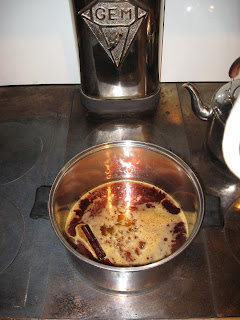Crock pots or slow cookers do their jobs well, but they are, in my opinion anyway, not quite the same as a kettle simmering on a stovetop. Furthermore, during the short intervals of my culinary life when a wood cookstove was not available, leaving a kettle to cook all day over a gas flame or electric burner was simply never an option because I am bothered by the energy consumption that these methods involve. (Disclaimer: I was accused the other day at the lunch table of being an environmentalist because we heat with wood and have only used our clothes dryer twice since February. I'm not an environmentalist; I think of myself as just old-fashioned. My wife tries to put a more humorous spin on the situation and likes to tell people that I'm allergic to the use of gas and electricity, and my students at school think that I'm Amish because they don't know the first thing about the Amish. The whole unvarnished truth of the matter is that I'm just a raging skinflint, and I don't like to see our hard-earned money fall unnecessarily into the hands of the power company or the propane provider--especially when we've got more firewood available to us than we know what to do with.)
At any rate, boiled cider is quite simple to make, and the end product is fascinating and versatile, though I haven't spent nearly enough time experimenting with it, and it is one of those foods which is perfect for a wood cookstove.
What I do is this:
1. Pour a 1/2 gallon of apple cider into a large, wide kettle.
2. Add a cinnamon stick.
3. Place on the back of the stove and let simmer slowly until it is reduced to 3/4 of a cup of liquid. Only occasional stirring is necessary toward the end of the cooking time.
 |
| The cider just after being put on the stove to simmer. |
 |
| The boiled cider a few minutes before I removed it from the fire. By this time, it was only a thin layer covering the bottom of the kettle. |
What happens as the cider boils is that it becomes a syrup, the thickness of which is totally dependent upon how long it is left to cook. A thinner syrup can be canned and later diluted with water to make "a refreshing drink," according to Ms. Cooper, so basically, you've made a cider concentrate.
If you use the proportions that I have listed above, however, what you will end up with once it is cool is a very thick syrup which is not unlike molasses or corn syrup on a very, very cold day. It is thick, and the flavor is intense and delicious. A side benefit of boiling cider is that your house smells lovely during the process, too.
"So now what do you do with it?" you may be asking.
My answer is, "Whatever you want to." I'm going to try using it in places where I would have ordinarily reached for the honey jar. However, in my next post, I'll share a recipe that I devised ten years ago this month which calls for the whole 3/4 of a cup of boiled cider. Stay tuned! I promise that it will be worth it.
Note 10/19/2017: Made sticky rolls using this instead of dark corn syrup. It worked well but was met with mixed reviews. Some didn't like it, others raved about it. I think I'd try it again.

I just may try this on top of my wood stove. I don't have a wood cook stove-but we heat our home only with wood heat, and our two wood stoves have nice flat surfaces on them.
ReplyDeleteI just found your blog-and wanted you to know I am enjoying reading your posts-we are retired and live in the ozarks in Missouri, enjoying the wildlife and our woods-and returning to the "simple" life again Kathy
Welcome to my blog, Kathy. Thank you for the kind words from a neighbor to the south! You're right; this recipe could easily be accomplished on a wood heating stove. I hope you enjoy it.
DeleteWish I knew if I could put things on our wood stove. I'm not sure what would happen to the soap stone if I tried something like this.
ReplyDeleteI love your stove!!! Back in the 70's a friend rented an old farm house that had a stove like that in the kitchen. We had many adventures learning to use that stove...some good some not so good!
ReplyDeleteThe folks over at King Arthur Flour sell a boiled cider, and have quite a few recipes for using it, namely in an apple pie...yummy yum yum! Again, thanks for your blog!
ReplyDelete